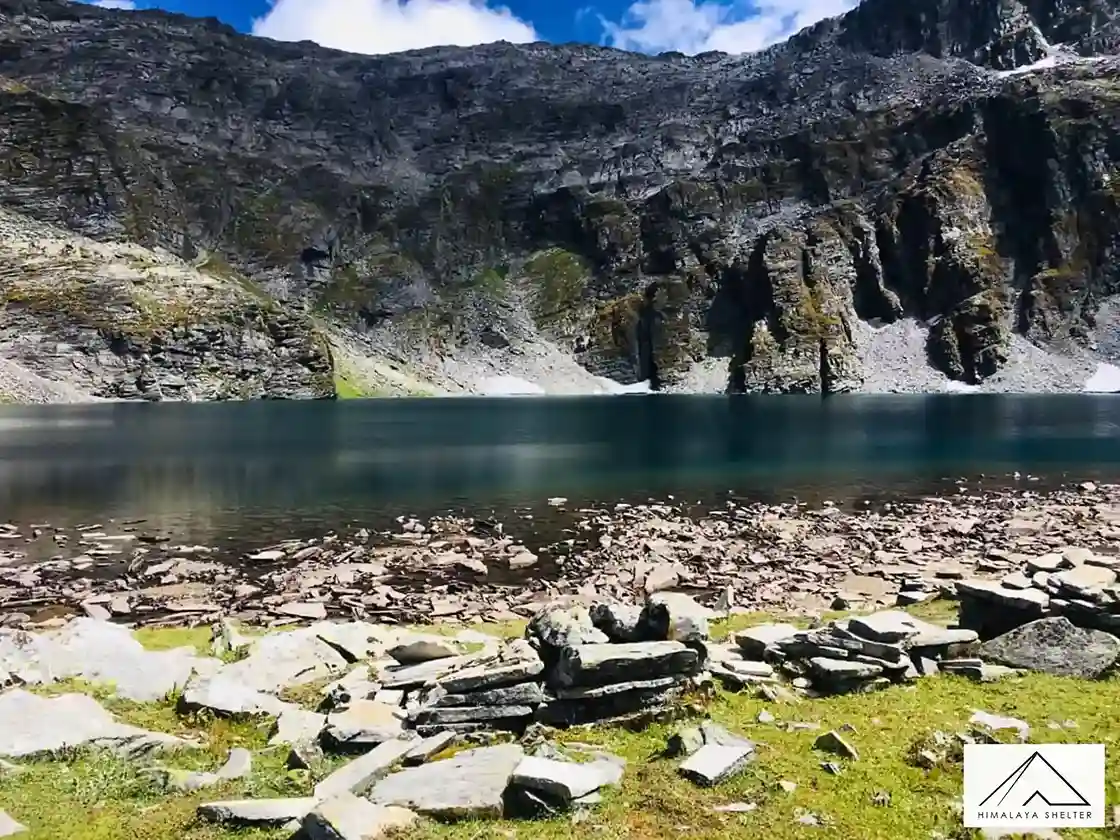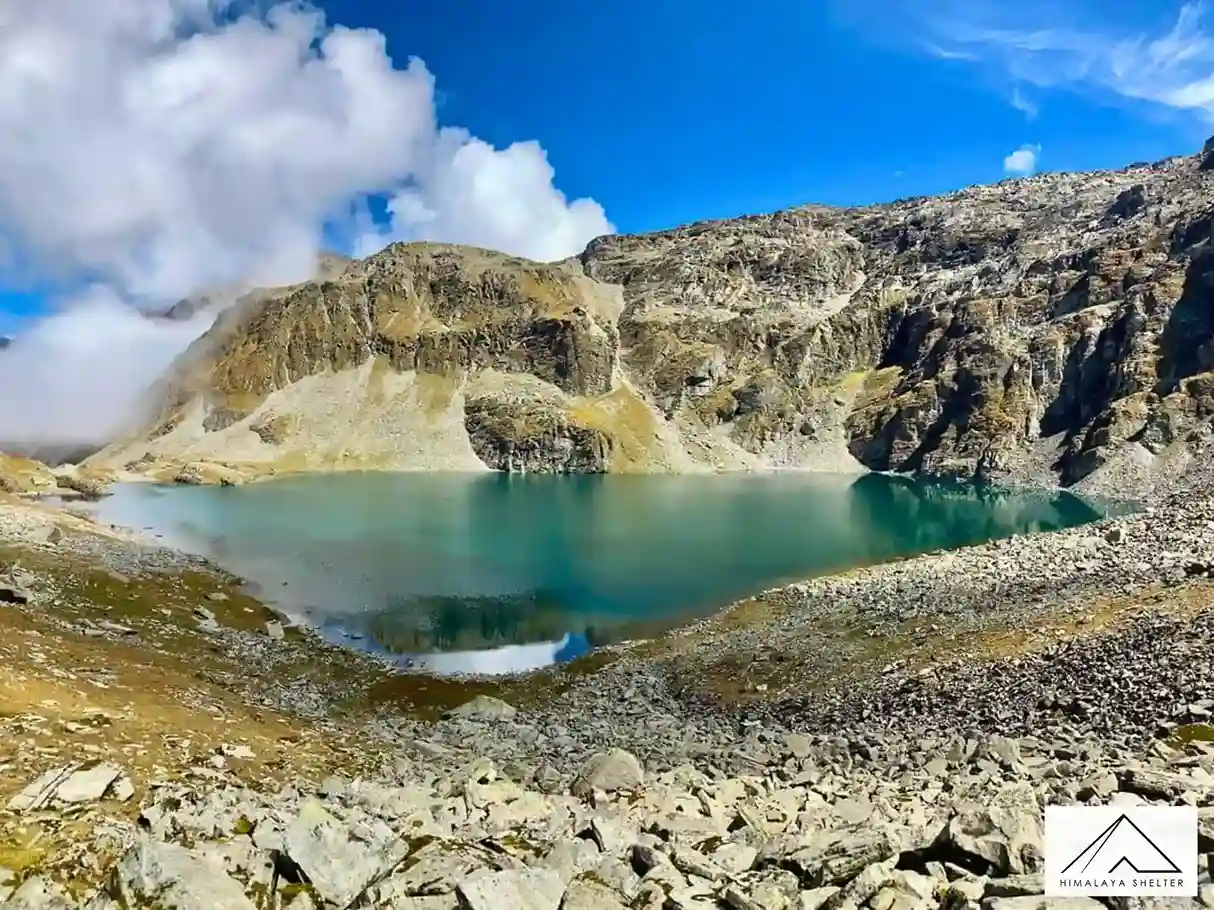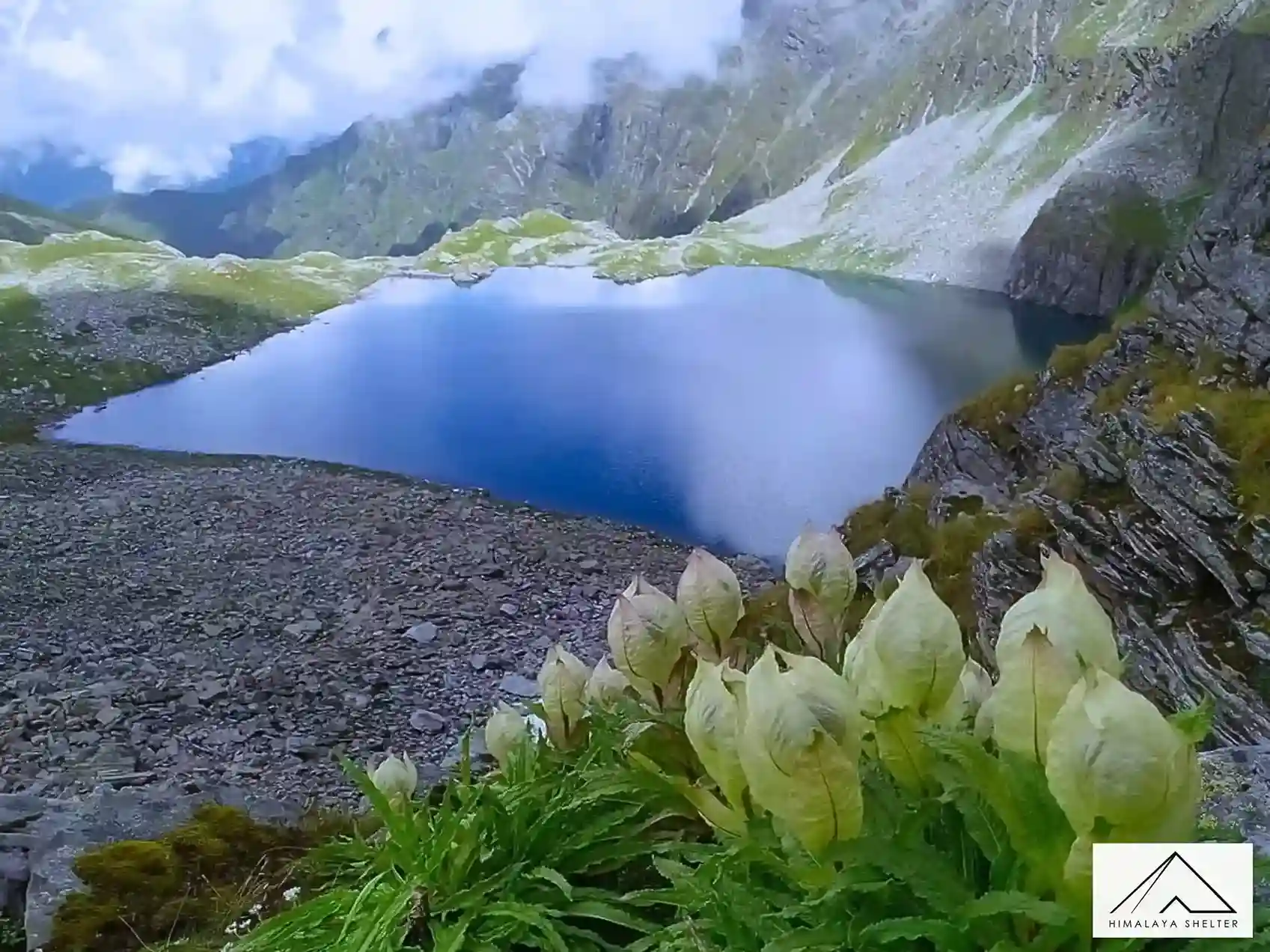
Baraadsar Lake Trek
TREK DIFFICULTY
Easy
TREK DURATION
10 Days
HIGHEST ALTITUDE
14,435 Feet
GROUP SIZE
12
TREK DISTANCE
61 Km
BASECAMP
Uttarakhand
BEST TIME
May to July and August to October
PICKUP POINT
Dehradun (Prince Chowk)
Baraadsar Lake Trek Overview
Himalayas are known for their incomparable divine beauty. The peace of mind these mountains offer cannot be found anywhere else. Whether they are the high mountain peaks of Trans-Himalayas or the lush green forests of the Shivalik Himalayas, they all have something unique to offer to mankind. The state of Uttarakhand is a well-known destination for trekking in the Himalayas. The spiritually inclined adventure lovers, trekkers, mountaineers and birdwatchers come here looking for spiritual treks where they can feel the serenity of Mother Nature, the tranquility of the mighty Himalayas, and the divinity of the sacred land. One such spiritual trek located in Uttarakhand is the Baraadsar Lake Trek. Baraadsar Tal, also called Bharadsar Tal, is a high altitude glacial lake located at the height of 4300 m. Baraadsar Tal is quite a challenging trek and is suitable only for experienced trekkers who have done at least one Himalayan trek before.
The Baraadsar Lake Trek starts from Sankri, Uttarakhand. Yes, the same Sankri village which is also the starting point for the Kedarkantha Trek, Har ki Dun Trek, Maldaru Lake Trek, Bali Pass Trek, and many other adventurous treks. Located in the Govind National Park, between Rupin and Supin valleys, this glacial lake trek offers spectacular views of high mountain peaks like Bandarpunch, Swargarohini, and Kala Nag (Black Peak). On this adventurous journey, you will be trekking through alpine meadows, lush green pine forests, ridges, and ancient Himalayan villages like Bitri, where you will be able to witness the beautiful old wooden homes of local villagers. Don't forget to pay homage to Mahasu Devta Temple, which is built in Kinnaur architecture. You will be amazed to see the beauty of this temple. When you embark on the Barradsar Lake Trek, you realise that every day this trek has something unique to offer you. Join us on this adventurous spiritual trek in the lap of Mother Nature in Uttrakhand Himalayas.

History of Baraadsar Lake Trek
Baraadsar Lake has a deep spiritual and mythological significance. Though there's no particular historical records available regarding the lake, locals believe that Baraadsar Lake received divine blessings and it can fulfill wishes and cure ailments and misfortune if one prays with full devotion.
As per local folklore, the lake was once the divine meeting place of god and the water of the lake was guarded by Naag Devta (serpent deity). Locals also claim that if anyone tries to pollute its water, he/she would face divine wrath. This is the reason that camping near the lake’s shore and boating in the lake are strictly restricted. Somehow, it helped the lake to maintain its pristinity.
Baraadsar Lake and its surrounding high passes were once part of the pastoral routes used by the Jaunsari and Himachali communities. Shepherds moved their flocks across Rupin and Supin valleys and used the lake as a halting point. In recent decades, Baraadsar Lake has gained attention due to its offbeat and less-explored trails in contrast to commercial trails.
Highlights of the Baraadsar Lake Trek
- Meadows of Devbasa: Devbasa is a beautiful campsite that offers majestic views of famous Himalayan peaks like Swargarohini and Bandarpunch and lush green grass meadows with blooming multicoloured flowers in summer. The endless skies and mesmerizing sunrise makes it one of the most picturesque destinations.
- Dhaldhar Ridge: Dhaldhar is a ridge-top campsite that provides a 360° panorama of towering peaks and valleys below. This is a dream place for photography lovers. The sunset here paints the sky in crimson hue and slowly turns the snow-clad mountains into golden. Clouds seem too close and make you feel like you're living among them.
- Baraadsar Base: It is located close to the Baraadsar Lake. You can feel an aura of peace and serenity here. Though the surrounding is stark with rocky slopes but looks beautiful and lively with alpine flowers. Trekkers camp here in starlit night before heading to Baraadsar Lake.
- Maldaru Tal: Maldaru Tal is a pristine lake which is often included in extended itineraries. Its turquoise-blue water magically reflects the surrounding peaks. Fringed with alpine wildflowers, this campsite offers trekkers nothing but a peaceful escape away from their daily life affairs.
- Masunda Dhar: Masunda Dhar is a ridge campsite used while descending. With distant charming Himalayan views, it provides a space to rest and rejuvenate under a serene atmosphere.
Difficulty Level of Baraadsar Lake Trek
The Baraadsar Lake trek reaches an altitude of approx 4,300 m and is considered one of the most difficult treks in Uttarakhand. It starts from Himri or Sankri and passes through Govind Wildlife Sanctuary and slowly ascends through Garhwal Himalayas.
The trek is not suitable for kids and elderly people. Beginners with good fitness can attempt it with proper guidance and preparation. The terrain includes forested trails, rocky paths, boulder-filled ridges and glacial zones. Even in early summer, patches of snow are here which make the route slippery.
The most challenging section is crossing the Baraadsar Pass which requires technical help like ropes, ice axe and sometimes crampons if snow is available. Hiring a professional guide or joining a team is highly recommended for safety.
The total duration of the trek is around one week (including travel days) and covers 55-60 km. On average, trekkers have to walk 6 to 8 hrs daily, depending on pace and stamina.
Weather can be unpredictable, proper acclimatization is important. Chilly winds, sudden rain and sub-zero temperatures are common at higher altitudes. Proper packing of warm clothes and rain protection are essential.
Overall, Baraadsar Lake trek is not a casual trek but a strenuous adventure meant for seasoned trekkers who are prepared to face harsh conditions and technical challenges.
Best Time to Visit the Baraadsar Lake Trek
For trekking to Baraadsar Lake, the best time or months are from May-June and September-October.
- Mid-May to June:
During this time, trails come alive with the arrival of summer. On lower camps, you will get to see lots of blooming rhododendrons and wild flowers and lush green meadows. The sky is clear enough to view peaks like Bandarpoonch and Swargarohini. The common daytime temperature remains around 12°C and at night time it usually goes around -2°C, depending on lower or higher camps and weather conditions.
- September–October:
During this time, the monsoon is over and views become sharper and vibrant. The trail remains dry and trees' leaves turn golden-brown which give a warm and cozy feeling. The sky is clear and the wind feels crisp. Temperature remains almost the same as summer, daytime it's 0°C to 10°C and at night time around 0°C. Trekking in late October, you may face snowfall so better complete it by early October.
- Avoid Monsoon (July–August): This time due to heavy rainfall, trails become slippery and inaccessible. The risk of leeches is also there. Clouds can reduce or block the visibility of mountain peaks.
How to Reach the Baraadsar Lake Trek
To reach the starting point of the Baraadsar Lake trek, first you have to travel to Dehradun, which is well connected by train, bus and flights from Delhi and other major cities. From Dehradun, the journey continues by road towards Mori in Uttarkashi district.
The drive takes around 7–8 hrs and passes through beautiful pine forests, apple orchards and small villages.
Mori serves as the last big settlement where trekkers can stock up on basic supplies. From Mori, the road goes further to Sankri and then towards Dhaula or Sankri side villages, which are used as the base camps for Baraadsar trek. Depending on the route chosen, the trek usually starts either from Dhaula village or from Sankri side via Rupin valley. Local jeeps are available from Mori to these villages.
Once at the base camp, the actual trek begins, taking you deep into dense forests of oak and pine, alpine meadows and high ridges. Reaching Baraadsar Lake requires crossing remote trails and high-altitude passes, which is why it is less crowded compared to other treks. The lake itself is situated at an altitude of around 4,300 m.
To make the journey smoother, it is best to travel through a well-organized trekking agency as the route is long and not well-marked.
Day 1: Drive from Dehradun to Himri (approx. 210 km, 8–9 hrs, 6,400 ft).
Day 2: Trek from Himri to Sarutal (6 km, 4–5 hrs, 7,700 ft).
Day 3: Trek from Sarutal to Badang (6 km, 4–5 hrs, 9,000 ft).
Day 4: Trek from Badang to Masunda Dhar (7 km, 5–6 hrs, 11,000 ft).
Day 5: Trek from Masunda Dhar to Dev Bhasa (6 km, 4–5 hrs, 12,200 ft).
Day 6: Trek from Dev Bhasa to Baraadsar meadow (7 km, 5–6 hrs, 13,120 ft).
Day 7: Excursion to Baraadsar Lake (4 km, 3–4 hrs, 13,500 ft) and return to Dev Bhasa.
Day 8: Trek back from Dev Bhasa to Badang (10 km, 6–7 hrs).
Day 9: Trek from Badang to Himri (12 km, 6–7 hrs).
Day 10: Drive back from Himri to Dehradun (210 km, 8–9 hrs).
Clothing
- 2-3 quick-dry T-shirts (full sleeves preferred)
- 2 trek pants (water-resistant if possible)
- 1-2 fleece jacket or woollen sweater
- 1 down jacket or heavy padded jacket
- 1-2 thermal inner set (top + bottom)
- Waterproof & windproof jacket
- Poncho or raincoat
- Woolen cap + Sun cap
- Neck gaiter or scarf
- 2–3 pairs of synthetic/woolen socks + 1 pair of woolen gloves
- Innerwear (quick-dry), towel
Footwear
- Trekking shoes (ankle-high, good grip)
- Floaters/sandals (for campsites)
- Gaiters (recommended due to snow/rock)
Trekking Gear
- 50–60L backpack with rain cover
- 20–30L daypack (for summit day & side hikes)
- Trekking poles (highly recommended)
- Headlamp with spare batteries
- Sleeping bag (–10°C to –20°C comfort rating, if not provided)
- Dry bags or ziplocks (to keep items dry)
Toiletries & Hygiene
- Toothbrush, toothpaste, biodegradable soap
- UV-protection sunglasses
- Sunscreen (SPF 50+), lip balm (SPF)
- Wet wipes, hand sanitizer
- Toilet paper, sanitary pads/tampons (carry back used items)
- Small quick-dry towel
Personal Medical Kit
- Diamox (for altitude)
- Crocin/Dolo, Combiflam, Digene
- ORS sachets, antiseptic cream
- Band-aids, gauze, crepe bandage
- Personal meds (if any)
- Betadine/Savlon
Documents
- Valid ID proof (Aadhaar, Voter ID, etc.)
- Medical certificate (fitness)
- Disclaimer form (from your trek operator)
Others
- Power bank
- Extra camera batteries (cold drains battery fast)
- Energy bars, dry fruits, glucose
- Notebook + pen (optional for journaling)
- Some cash (no ATM in region)
Technical Gear (usually arranged by trek organizers, but confirm)
- Crampons/microspikes
- Ice axe
- Climbing helmet
- Harness, carabiners, ropes
In Himalaya Shelter, we provide you with the option to customize your Baraadsar Lake trek experience. Whether you're an avid mountaineer, an adventure seeker or a group of friends, you can opt for our personalized tailor-made expedition program.
This customized program will be exclusively designed for you, taking into account your specific requirements for transportation, accommodation, meals, technical equipment and any other premium facilities you may need during the trekking.
Starting from Himri or Sankri village, the Baraadsar Lake trek passes through Govind Wildlife Sanctuary and scenic destinations before reaching the lake.
Himalaya Shelter ensures your journey is safe and memorable with experienced local guides, technical support and all necessary permits. You can even request offbeat routes or sunrise hikes for a more immersive Himalayan experience.
Moreover, no other participants will be added to your group. Choosing a customized program will enable you to enjoy your journey without any hesitation.
Day 1: Drive from Dehradun to Dhaula
Drive: 200 km, 8-9 hrs
Altitude Gain: 2,100 ft – 4,900 ft
Today is going to be the first day of the adventurous Baraadsar Lake Trek. Early in the morning, you will depart for Dhaula from Dehradun; a small village in Uttarakhand. Dehradun to Dhaula is a beautiful road trip passing through curvy Himalayan mountain roads.
Let’s know some interesting facts about today’s road trip to Dhaula. You will pass through the less explored Himalayaan region like Purola and Mori along with the famous destinations like Mussoorie. You will witness spectacular views and some ancient heritage sights on the way that represents our country’s rich culture. One such place is Lakhamandal. We will talk about it later though.
Kempty…You must have heard this word right? On the way to Sankri when you leave Mussoorie, you will pass through beautiful Kempty waterfalls also known as Kempty Falls. You will get a chance to witness the beauty of this famous Himalayan waterfall.
When you start riding on the Mussoorie – Yamunotri road, you will come across another beautiful place named Lakhamandal. It is not exactly on our way but If the time allows, you can pay a visit to this temple. While passing the town you will realize why Uttarakhand is called Devbhumi. Lakhamandal is mentioned in the ancient Indian scripture, the epic Mahabharata. This temple is famous not only because it is mentioned in Mahabharat, but also because of its significant architecture. The temple is dedicated to lord Shiva.
Let’s move a little further, and you will reach Ganganani, famous for its natural hot springs. Ganganani is a small village in Uttarakhand near Harshil Village. Here, you will take a break by the riverbank. All Indian rivers are considered sacred as they sustain countless lives. Sit down, dip your legs in the water, and listen to the soothing music of the river. You will reach Dhaula late in the evening where you will stay in a tent at our campsite.
Day 2: Dhaula/Himri to Saru tal via Bhitri Village
Trek: 8 km, 5 hrs
Altitude Gain: 4,900 ft – 7,700 ft
Today’s trekking route to Bitri is no easy feat, requiring a daunting 2700ft ascent through dense pine forests, with the first break point, Kujraili, perched 1800ft higher after just an hour’s climb. The forest trail, though enchanting, presents a challenge as it forks multiple times, necessitating guidance from passing villagers to navigate the right path and avoid the risk of getting lost. It’s crucial to stock up on water, as the trail offers scarce water sources; departing Himri with at least 2 litres ensures hydration throughout the arduous 4-hour uphill trek.
Upon finally reaching Bitri, a sense of tranquility envelops visitors amidst the village’s modest beauty, home to just over 100 families. Welcoming young children eagerly greet arrivals, guiding them through the maze of charming wooden houses towards the heart of the village, where a humble school and a captivating temple await. The temple, adorned with intricate wooden carvings and showcasing Kinnaur-style architecture, stands as a testament to the village’s rich cultural heritage.
After exploring the village’s cultural gems, travellers can seek respite beneath the shade of the Moruban tree for a well-deserved lunch break before venturing onwards to the campsite at Saru Taal. This picturesque meadow, nestled amidst the tranquil landscape, features a central lake, although it remains dry for most months of the year, with the nearest water source located nearly a kilometre away, emphasizing the importance of preparedness for remote adventures. On every step, this trek offers a glimpse into the simplicity and resilience of mountain life amidst the breathtaking landscapes of the Himalayas. Tonight we will stay at the Saru Tal campsite.
Day 3: Saru Tal to Badang
Trek: 7 km, 4-5 hrs
Altitude Gain: 7,700 ft – 9,700 ft
As the sun casts its golden rays over Saru Taal, a new day beckons for another exhilarating trek towards Badaang. Bid farewell to the tranquil lake and lace up your boots, ready to embark on a moderate journey to higher altitudes. The path ahead promises a rewarding trek along the same mountain slope, ascending slightly higher with each step. Covering 7 kilometres and gaining over 2200 feet in elevation, this trek offers breathtaking views and memorable encounters along the way.
Within the first hour, a challenging climb leads you to a babbling stream, marking your entry into a serene deodar and pine forest. Amidst the lush foliage, keep watch for the playful Himalayan langurs and the colourful array of birdlife that grace the canopy above. As you trek along the rugged trail, surrounded by nature’s splendour, the landscape gradually transitions, offering moments of respite before the final push towards Badaang. The last two kilometres present a renewed sense of determination, with each step bringing you closer to your destination. Arriving at Badaang, be greeted by a picturesque meadow embraced by the towering deodar forest, a tranquil oasis for weary trekkers. Settle into the campsite, serenaded by the gentle melody of the nearby stream, and reflect on the journey thus far. Get ample rest since tomorrow’s trek is going to be a challenging one.
Day 4: Badang to Dhal Dar
Trek: 10 km, 5-6 hrs
Altitude Gain: 9700 ft – 11,300 ft
Embarking on the challenging trek from Badang to Dhal Dhar in the Himalayas unfolds as a test of endurance amidst breathtaking landscapes. Each step forward in the Himalayas becomes a testament to human endurance and the spirit of exploration amidst nature’s grandeur. The journey begins with a three-hour ascent through dense oak forests, marked by steep climbs that gradually lead to the ridge where the forest thins out. Vijay Top, standing a thousand feet higher than Badang, offers a stunning viewpoint, with Masundha Dhar lying ahead. The trail transforms into a mesmerizing ridge walk, revealing panoramic vistas of Swargarohini, Bandarpoonch, and Ralgan peaks amidst abundant of rhododendron plants. Over the next four hours, the ridge walk unveils a vast expanse of the Himalayas, captivating trekkers with its timeless beauty. Amidst this rugged terrain, the village of Liwadi emerges as a testament to human resilience. As trekkers approach the Dhal Dhar campsite nestled in a narrow valley, the sight of white rhododendrons adorning the hillside offers a moment of tranquillity.
At night spend some time in star gazing and fall asleep in the lap of Mother Nature.
Day 5: Dhal Dar to Dev Basa
Trek: 4-5 km, 2-3 hrs
Altitude Gain: 11,300 ft – 11, 900 ft
The trek to Dev Basa is a quick yet exhilarating two-hour journey. Starting with a 500-foot climb over half a kilometre, followed by a gentle descent, trekkers reach the campsite nestled between two mountains on a rocky plain. Despite the rugged terrain, the camp offers a tranquil retreat. Surrounded by rocky peaks and swept by strong winds, the campsite provides a thrilling adventure. From Dev Basa’s viewpoint, at an altitude of 11,800-11,900 feet, breathtaking views of the Gangotri range unfold. Though short, extending the journey slightly would ease the strenuous ascent to Bhardsaar Lake.
Day 6: Dev Basa to Baraadsar meadows (Baraadsar Base camp)
Trek: 10-12 km, 6-7 hrs
Altitude Gain: 11,900 ft – 13,120 ft
The trek from Dev Basa to Bharadsar camp presents the ultimate challenge of the six-day journey amidst the rugged terrain of the Himalayas. Two routes offer different experiences: a longer, winding path around the mountain, or a shorter, steep ascent crossing a pass directly to the campsite. As trekkers navigate through bouldery terrain and occasional snow patches, they face a gruelling 4.5-hour climb to reach the cross-over point or ridge, with the campsite still 3 hours away.
Beyond the ridge, the trail becomes treacherous, with rocky paths and snow gaps making for a risky journey. From a vantage point above the camp, Bharadsar Lake emerges, its partly frozen, darkened surface reflecting the imposing rocky peaks of the Himalayas. A challenging 4-hour trek leads to this breathtaking sight. Yet, beyond the ridge, the environment turns hostile, with bone-chilling weather and rugged terrain testing the resolve of every trekker.
At the Bharadsar meadow campsite, necessities such as water and firewood are scarce, forcing trekkers to rely on melting snow for survival.
Day 7: Baraadsar Base camp to Baraadsar Lake and descend to Dev Basa
Trek: 10-12 km, 4-5 hrs
Altitude Loss: 13,120 ft – 11,900 ft
The Bharadsar lake is not visible from the Bharadsar meadow campsite. You get a distant view of the lake from the ridge you came from.
The lake is a couple of hours away from the Bharadsar meadow camp. It’s a trek over rocks and moraines which requires you to step carefully.
From the Bharadsar lake, retrace your steps to the Baraadsar meadow campsite. From the camp, take the straight path to the ridge top. If there is snow, it will be an easy climb up to the ridge which takes an hour.
The descent on the Dev Basa side is steep and slippery. The direct ridge route is much shorter than the roundabout route. Take the direct route to the ridge even on the way up. A 3-hour trek from Bharadsar base camp brings you back to Dev Basa where we will pitch up our camp and stay for the night. Get ample rest and rejuvenate yourself.
Day 8: Dev Basa to Upper Rehala
Trek: 7-8 km, 5-6 hrs
Altitude Loss: 11,900 ft – 8,840 ft
Descending from Dev Bhasa to Upper Rehala proves a demanding descent, requiring careful navigation over loose stones and rocks. Retracing your path to Dhal Dhar, you then veer onto a new trail, where the initial stretch tests the endurance of every trekker. About an hour into the descent, streams offer a welcome opportunity to replenish water supplies, providing a refreshing break. As the trail unfolds, it transitions from rugged terrain to verdant meadows before leading into a captivating pine forest. Emerging from the forest, the path winds through terraced farms adorned with crops like Rajma and wheat. Amidst these picturesque surroundings, we will find a tranquil spot amidst green patches to set up camp for the night.
Day 9: Upper Rehala to Kasla and Drive to Sankri
Trek: 3 km, 2 hrs
Drive: 39 km, 2 hrs
Altitude Loss: 8,840 ft – 6,500 ft
The day begins with a leisurely downhill stroll, accompanied by the soothing sounds of flowing streams. After about an hour, you’ll pass through the villages of Rehala and Karla, followed closely by Bitri. As you continue your descent, the terrain becomes steeper, eventually leading you to the banks of the Supin River, where it converges with the Obra River. Here, a quaint tea shop awaits, offering a welcome respite. From this point, it’s a couple of hours of uphill trekking to reach Jakhol, where a vehicle awaits to transport you to Sankri; a small village in Uttarakhand. At Sankri, we will check in to the cosy Guest house of Himalaya Shelter.
During the trekking season, Sankri bustles with activity, serving as the base for popular treks such as Kedarkantha Trek, Har ki Dun Trek, Bali Pass Trek, Borasu Pass Trek and Offbeat Treks and Rupin Supin Traverse, Maldaru Tal Trek, Devkyara Trek and many others. The vibrant atmosphere and breathtaking surroundings make Sankri a hub of adventure and exploration in the Himalayas.
Spend the night in the comfort of the guest house and feel yourself grateful that you could complete this challenging yet spectacular offbeat trek.
Day 10: Sankri to Dehradun
Drive: 190 km, 7-8 hrs
Altitude Loss: 6,500 ft – 2,100 ft
The Baraadsar Lake Trek concludes today as we depart from Sankri. We anticipate reaching Dehradun by late afternoon or early evening. En route, our journey will take us through the lesser-explored and exceptionally scenic areas, particularly as we drive up to Mori, which stands out as one of the most picturesque stretches along the entire route. Mori is a lesser-known destination for a wonderful water rafting adventure.
Going back home is always a bittersweet moment, but the journey is made easier by taking the picturesque road to your next destination. As we leave behind the dense pine forests and descend towards the city, the landscape slowly changes and opens up into wider roads. Hold on to as many beautiful memories as you can in your heart and bid farewell to the Himalayan trails with gratitude and fondness.
Our treks are specially designed by the experienced team at Himalaya Shelter, taking you on an adventure of a lifetime all while making you connect not only with the bountiful nature but also with yourself and with others on the trek with you creating wonderful memories which will last you a lifetime. All Himalaya Shelter treks are guided by experienced Trekkers having vast knowledge and experience of the region, providing with insightful information and stories pertaining to the region’s flora and fauna and the history of the region whilst the trek. It is safe to say that on successfully completing the trek, one will gain tremendous insight and experience along with lifetime memories.
Inclusions
- Transport support from Dehradun to Dehradun ( Pick-up location: Prince Chowk, near Dehradun Railway Station Pick-up Time: Around 7:30 am )
- Accommodation – At Base Camp, stay at a local homestay or guest house for one night each, which will give you an insight into the authentic lifestyle of the locals.( INR 5000 per person extra for single sharing throughout the trek )
On Trek stay in a 2-person Vango Halo Pro/A-Shape tent, which is to be shared by two trekkers, built to withstand extreme weather conditions and at the same time making you comfortable after a hard day’s trek. - Camping Equipment – specially designed sleeping bags that can withstand harsh weather conditions, foam mattresses. Other safety gear like microspikes, gaiters, an ice axe, and helmets will be provided.
- Medical Kit – our team will be equipped with an extensive medical kit, which our team is trained and experienced to use. Oxygen cylinders are used after they are thoroughly inspected throughout the Trek. Even campsites have large oxygen cylinders as backups.
- Permission - Forest entry charges for Indian nationals (Additional charges will be applicable for international tourists)
Meals – Breakfast, packed lunch (on trek days), evening snacks, and dinner will be served. A hearty, delicious, and nutrition-filled Veg meals with egg preparation will be provided throughout the trek. (Jain and Vegan Food can also be arranged on prior notification.)There will be a dedicated Kitchen Tent along with a dining tent, which will have a dining table too. - Our Team – A highly experienced and AMC-certified Trek Leader who will help ensure that the entire trek goes smoothly and safely while navigating the challenging conditions during the trek, and is skilled enough to navigate any medical emergency that can arise during the trek. Local and route Guides who are well-versed with the region and provide an in-depth insight into the local customs and knowledge of the flora and fauna endemic to the region. A dedicated Kitchen staff, which includes a Cook, a helper, and other support staff. There will also be porters and mules to carry common equipment.
- Cloakroom - We have a cloakroom facility available for extra luggage. Every trekker is permitted to leave their luggage behind at no charge.
Exclusions
- Personal expenses like tips, personal medicines, phone calls etc.
- Travel Expenses - Travel expenses from your hometown to the mentioned Pick-Up Point are not included in the trek fee.
From the scheduled pick-up spot to the base camp, we have our own fleet of vehicles like Bolero, Innova, Dezire, or Tempo Traveler (12-seater). This is be shared by trekkers for a pre-decided amount. All vehicles are non-AC. - Personal Equipment - Any personal gear like jackets, shoes, cutlery, or backpacks are not included in the trek fee. We recommend renting them from our Rental Store for an affordable fee. This can be pre-arranged to avoid last-minute hang-ups.
- Offloading - We encourage carrying your backpack to get into the true spirit of trekking. However, if needed, you can opt to offload your personal luggage of up to 12 kgs for an additional cost of INR 500 per bag per day.
- Trek Insurance - A mandatory trek insurance fee is charged in addition to your trek fee. Since most medical insurance doesn’t cover adventure activities, trek insurance offers essential coverage, enhancing your safety without a significant financial burden.
- Buffer day on the trek - We have kept a buffer day on the trek to account for any weather-related delay. If this is utilized, you will need to pay an extra amount to your trek leader.
Anything apart from inclusions - Please carry a lunch box for a packed lunch/breakfast to avoid using polythene and Aluminium foil.
Keeping the Himalayas clean is our own responsibility. Reduce the use of Plastic when you are in the abode of the Sacred Himalaya.
Read More on Baraadsar Lake Trek
Photo Gallery




Treks by Categories
Treks By Month

Treks By Experience






